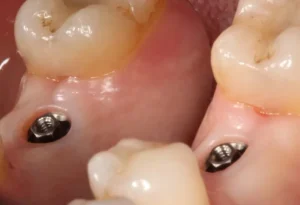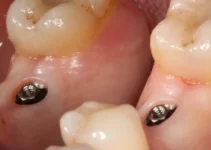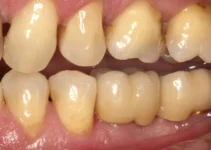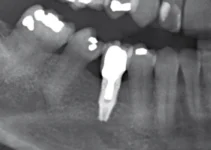Experiencing dark gums around the implant can be concerning for many dental patients. This discoloration is often a sign of tissue trauma or poor blood supply in the area surrounding the dental implant. Factors such as the surgical technique used, the type of materials in the implant, and the patient’s own healing response can contribute to this issue. Proper diagnosis and timely intervention by a specialist are crucial to manage and potentially reverse such changes, ensuring both the health of the gum tissue and the success of the implant.
Causes of Dark Gums Around the Implant
Dark gums around dental implants can be a cause of concern for many patients. There are several factors that can contribute to this condition, often related to the health and maintenance of the implant site. Understanding these causes can help in preventing and addressing the issue effectively.
One of the primary causes of darkening gums around an implant is related to poor oral hygiene. Other contributing factors may include underlying systemic conditions, inadequate blood supply, and the type of materials used in the implant. Let’s explore these causes in more detail to understand their impact and prevention methods.
Early detection and intervention are crucial for preventing complications. If you notice any changes in the color of your gums around an implant, it is essential to consult with your dentist promptly. Timely resolution can prevent further issues and maintain the health and aesthetics of your dental implant.
Poor Oral Hygiene
Poor oral hygiene is a significant contributor to dark gums around dental implants. When patients fail to maintain proper oral care, plaque and bacteria can accumulate around the implant site. This can lead to inflammation and infection, which manifest as darkened gums. To prevent this issue, it is essential to follow a rigorous oral hygiene routine. This includes brushing at least twice a day, using an antibacterial mouthwash, and flossing daily. Additionally, regular dental check-ups are necessary to monitor the health of the implant and surrounding tissues.
Neglecting oral hygiene can also lead to peri-implantitis, a condition similar to periodontitis but occurring around an implant. This infection can cause the gums to recede and darken due to tissue damage and poor blood circulation.
Maintaining good oral health is not only pivotal for the longevity of the implant but also for the overall well-being of the patient. Proper care and regular visits to the dentist can significantly reduce the risk of darkened gums and other related complications.
For more information on how to maintain your dental implants and prevent complications, consider reading our other articles on implant care and oral health best practices.
Preventive Measures for Avoiding Dark Gums
Maintaining healthy and pink gums is crucial for overall oral health. Several factors can lead to the darkening of gums, such as poor oral hygiene, smoking, certain medications, and even genetics. However, by incorporating preventive measures into your daily routine, you can significantly reduce the risk of developing dark gums. Below are essential strategies to consider:
Preventive care is not just about keeping your teeth clean; it is also about ensuring the health of your gums. Adopting the right habits can help you maintain gum health and prevent discoloration. In this article, we’ll discuss preventive measures such as regular dental check-ups, proper brushing techniques, and the use of antibacterial mouthwash.
Regular Dental Check-ups
One of the most effective ways to prevent dark gums is through regular dental check-ups. Visiting your dentist at least twice a year allows for early detection of any gum issues, enabling prompt treatment and prevention of further complications. During these visits, your dentist can check for signs of gum disease, tartar build-up, and other factors that could lead to gum discoloration.
Dental professionals use specialized tools to clean parts of your mouth that are difficult to reach with a toothbrush alone. This thorough cleaning helps remove plaque and tartar that can contribute to gum discoloration. Regular visits also offer an opportunity to discuss any concerns you may have about your gum health and learn more about effective oral care practices.
Proper Brushing Techniques
Brushing your teeth properly is another key preventive measure to avoid dark gums. It’s not just about how often you brush, but also how effectively you do it. Use a soft-bristled toothbrush to brush your teeth at least twice a day. Hard bristles can damage your gums, leading to inflammation and discoloration over time. Make sure to use fluoride toothpaste and employ gentle, circular motions. Avoid brushing your teeth aggressively, as it can cause gum recession and make your gums more susceptible to bacteria and discoloration. Don’t forget to brush along the gum line where plaque and bacteria are more likely to accumulate.
In addition to brushing, consider incorporating flossing into your daily routine. Flossing helps remove food particles and plaque from between your teeth and along the gum line, preventing the formation of dark spots on your gums. Many dentists recommend flossing at least once a day for optimal gum health.
Use of Antibacterial Mouthwash
Incorporating an antibacterial mouthwash into your oral hygiene regimen can help prevent dark gums. Mouthwash reaches areas of your mouth that brushing and flossing might miss, providing a comprehensive clean. This can reduce the number of bacteria present in your mouth, thereby lowering the risk of gum infections and discoloration.
Choose a mouthwash that contains antimicrobial ingredients such as chlorhexidine or cetylpyridinium chloride. These compounds can help reduce plaque build-up and prevent gum disease, which can lead to dark gums. Swish the mouthwash around your mouth for about 30 seconds, making sure it reaches all areas, then spit it out.
It’s important to note that while antibacterial mouthwash can be beneficial, it should not be used as a substitute for brushing and flossing. Think of it as a supplementary step in your daily oral care routine to ensure your gums stay healthy and pink.
By implementing these preventive measures, you can significantly lower your chances of developing dark gums. For more information on maintaining optimal oral health, be sure to check out our other articles.
Treatment Options for Dark Gums
Dark gums can be a cosmetic concern for many individuals. They may result from a variety of factors, including genetics, smoking, certain medications, and systemic diseases. Fortunately, there are several treatment options available to address this issue. Each treatment has its own set of benefits and is chosen based on the specific needs of the patient. Here, we will explore some of the most effective methods for treating dark gums.
A comprehensive approach often involves a combination of professional dental treatments and at-home care. The goal is to improve the appearance of the gums while ensuring overall oral health is maintained. Let’s delve into one of the primary treatment options: professional cleaning.
Professional Cleaning
Professional cleaning, also known as dental prophylaxis, is one of the most basic yet essential treatments for dark gums. This procedure involves the removal of plaque and tartar from the teeth and gums. Plaque is a sticky film of bacteria that can accumulate and lead to gum discoloration if not properly managed. Tartar, on the other hand, is hardened plaque that can only be removed by a dental professional.
The benefits of professional cleaning include:
- Removal of extrinsic stains
- Prevention of gum disease
- Improvement of overall gum health
During a professional cleaning, dentists or dental hygienists use specialized tools to clean the teeth and gums thoroughly. Scaling is a technique used to remove tartar from above and below the gum line. Polishing follows scaling to remove surface stains and smooth the teeth, which helps to prevent future plaque buildup. Together, these methods help to restore the natural color of the gums.
In addition to improving the appearance of the gums, professional cleaning also provides a significant health benefit. Oral hygiene is closely linked to overall health, and regular cleanings can reduce the risk of systemic issues such as cardiovascular disease and diabetes. For patients with dark gums, this treatment can serve as the first step in a comprehensive gum lightening plan.
Stay tuned for more in-depth articles on advanced treatments and home care tips to further improve your gum color and health!
Long-term Management and Care
Proper long-term management and care of dental implants are essential to ensure their longevity and functionality. Dental implants can last many years, even decades, if cared for correctly. This section will discuss critical aspects of managing and maintaining the health of dental implants.
Implants require consistent and comprehensive care, much like natural teeth. The role of regular monitoring by a dentist, avoiding harmful habits like tobacco use, and maintaining rigorous oral hygiene cannot be overstated. By integrating these practices into a daily routine, patients can protect their investment and enjoy a healthy smile.
A thorough understanding of these care aspects helps patients stay proactive in their dental health. Educating patients about the importance of regular dental check-ups, the detrimental effects of smoking, and proper oral hygiene techniques is paramount to long-term success.
Regular Monitoring by a Dentist
Regular dental check-ups are critical for the long-term success of dental implants. A dentist can identify potential issues early, such as peri-implantitis or other gum diseases, allowing for timely intervention. Studies have shown that patients who visit their dentist regularly have a significantly lower risk of implant failure.
During these check-ups, dentists can also ensure that the implant is properly integrated into the jawbone and that there are no signs of mechanical wear or other issues. Regular monitoring helps maintain the health of both the implant and the surrounding gum tissue.
Routine visits typically involve:
- Professional cleaning to remove plaque and tartar buildup.
- Examination of the implant and adjacent teeth for any signs of complications.
- Assessment of oral hygiene practices and recommendations for improvement if necessary.
By adhering to a schedule of regular dental visits, patients can ensure that any problems are caught early and managed effectively, thereby extending the lifespan of their implants.
Avoidance of Tobacco Products
Avoiding tobacco products is crucial in maintaining the health of dental implants. Smoking and other tobacco use can significantly increase the risk of implant failure due to the adverse effects on oral health.
Tobacco use impairs blood flow to the gums, which can slow down the healing process after implant surgery and lead to complications. Additionally, smoking increases the risk of peri-implantitis, an inflammatory condition that affects the soft and hard tissues around the implant.
Research indicates that smokers are at a higher risk for:
- Bone loss around the implant site.
- Delayed healing post-surgery.
- Increased plaque and tartar accumulation.
Patients who use tobacco products should be counseled on the importance of cessation and provided with resources to help quit smoking. Reducing or eliminating tobacco use can significantly improve the odds of long-term implant success.
Maintaining Good Oral Hygiene Practices
Maintaining good oral hygiene is fundamental to the longevity of dental implants. Proper brushing, flossing, and regular use of antimicrobial mouth rinses can prevent plaque buildup and gum disease.
Implant patients should be educated on specific oral hygiene techniques that are most effective for implants. This includes using a soft-bristle toothbrush, non-abrasive toothpaste, and interdental brushes or floss to clean around the implant.
Effective oral hygiene practices include:
- Brushing at least twice a day with a soft-bristle toothbrush.
- Flossing daily to remove plaque and food particles between teeth and implants.
- Using an antimicrobial mouth rinse to reduce bacteria in the mouth.
By adhering to these practices, patients can significantly reduce the risk of peri-implant diseases and ensure the long-term success of their dental implants. Consistent oral hygiene is a critical component of overall dental health.
For more information on maintaining dental implants, consider reading our other articles on advanced oral care techniques and the latest in dental implant technology.
Frequently Asked Questions About Dark Gums Around Implants
If you have noticed darkened gums around your dental implants, you might have some questions about what could be causing this issue and how it can be addressed. Below, we explore a common concern related to this condition.
Why do my gums look dark around the implant?
Dark gums around dental implants can be caused by several factors. One common reason is the use of metal implants, particularly those made from titanium, which can sometimes cause a darkening of the gum tissue if the implant begins to show through the gum. Additionally, inflammation or infection could also lead to darker gum tissues. Proper diagnosis by a dental specialist is vital to determine the specific cause and to decide the appropriate treatment.

My name is Salman Kapa, a 73-year-old expert in bone regeneration and dental implantology. With decades of experience in the field, I am dedicated to advancing our understanding of oral health and hygiene. Through my research and writing, I aim to contribute to the development of innovative solutions in dental care.




